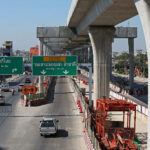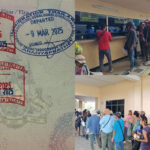Three public hearings will decide the fate of an ambitious bridge project connecting Samui Island to mainland Thailand.
According to the Bangkok Post, Thailand has resumed public hearings on an ambitious bridge project that would connect the famous tourist island of Koh Samui to the Thai mainland. The first round of hearings identified possible entry and exit points on the mainland and the island.
The toll bridge is expected to have two entry and exit points on the mainland, one in the Don Sak district of Surat Thani province and the other in the Khanom district of Nakhonsitthammarat province. The total length of the bridge and access roads in the two districts will be 37 kilometres, with the bridge itself spanning 25 kilometres over the Gulf of Thailand.
The chosen location for the bridge was one of seven proposed in the first round of hearings. The second round of public hearings began on Monday on Samui Island before moving to Nakhonsitthammarat on Tuesday and Surat Thani on Wednesday. The proposed location of the bridge will be the main topic of discussion.
The Expressway Authority of Thailand oversees the project and requires three rounds of public hearings. The final hearing is expected to conclude in October next year.
According to the agency, construction of the bridge is expected to begin in 2029 rather than 2028, as originally planned. If the project passes a feasibility study and environmental impact assessment and is approved by the current government, it will be opened in 2033.
The Expressway Authority of Thailand believes the bridge will provide a convenient alternative for people travelling between the island and the mainland, which is currently only accessible by sea or air. In addition, the project’s implementation will benefit Samui Island’s tourism industry. However, not everyone agrees with this viewpoint.
The construction of such a large-scale infrastructure facility will undoubtedly have a significant impact on the region’s ecology and the lives of local residents. Therefore, holding public hearings and considering the opinions of all stakeholders play an important role in making an informed decision on this project.
Samui Island is known for its picturesque beaches, coral reefs, and rich biodiversity. However, the construction of the bridge and increased tourist traffic could lead to water pollution, destruction of natural habitats, and disturbance of the ecological balance.
In addition, critics of the project fear that the bridge could change the island’s authentic atmosphere and negatively affect local communities’ traditional way of life. Increased tourist numbers and infrastructure development could lead to over-commercialisation and loss of Samui’s cultural identity.
Proponents of the project, on the other hand, argue that the bridge will contribute to the region’s economic growth by creating new jobs and attracting investment. Improving the island’s transport accessibility could boost tourism and other economic sectors.
Given the project’s scale and potential impact, it is crucial to conduct a thorough assessment of all possible risks and benefits and consider the views of all stakeholders. Only a balanced and comprehensive approach will enable the best decision to be made that will benefit local residents, businesses, and the environment.
The upcoming public hearings will allow open dialogue and exchange of views on this complex issue. The outcome will largely determine the fate of the Koh Samui Bridge project and the future of this unique region of Thailand.
More Articles Here
More Articles Here










